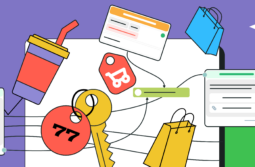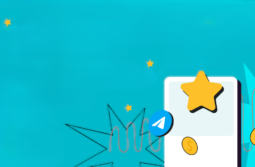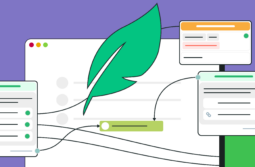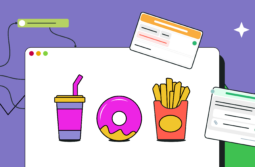According to research done by Euromonitor at the end of 2019, the global travel industry was expected to grow by 3.3% by 2024. COVID-19 obviously changed the outcome a little: tourism has been one of the most impacted economic sectors as a result of the crisis.
On the other hand, due to confinement, people have developed new consumer behaviors and a great hunger for traveling that can pay off in the future. In these circumstances, travel industry chatbots are a top-notch tool to stay connected with your audiences 24/7.
Content:
- How chatbots are changing the travel industry
- Travel industry chatbots help generate, nurture, and convert leads
- Travel industry chatbots ensure ultimate customer service
- Which of the following would you use a chatbot for?
- Scenarios, tips, and examples for building a travel chatbot
- Local insider: providing tips and busting myths
- Flight and hotel booking assistant
- 24/7 customer service agent
- How to get users for your travel chatbot
- Make use of direct response marketing
- Unlock the power of Facebook
- Collect subscribers on your website
- Building travel industry chatbots with SendPulse
- To finish up
How chatbots are changing the travel industry
The same research showed that online travel sales will soon have the largest share of all travel sales and a quarter of all bookings will be made via mobile. Considering that society has recently become incredibly tech savvy with online services, this sounds more than relevant.
Messaging is a core mobile feature. We do all sorts of things on mobile phones and chit chat about them simultaneously. These conversations have already become a major part of any user experience. And that’s when chatbots take the stage: providing your prospects, leads, and customers with a time-saving and hassle-free service.
Well-crafted and smart travel chatbots will always outperform mobile apps because:
- they don’t interrupt the messaging experience;
- they don’t need to be installed and don’t take up space;
- they have a familiar chat interface;
- they are cheap to build and maintain.
Moreover, chatbots can include a variety of features, creating a wholesome experience that can only be delivered by a small number of apps. In fact, there are already a bunch of chatbots that have become go-to assistants for travelers around the world.
For instance, the Instalocate chatbot can track flights, perform check-ins, share information with friends and family, help with compensation, and book taxis — all in one easy-to-use chatbot!
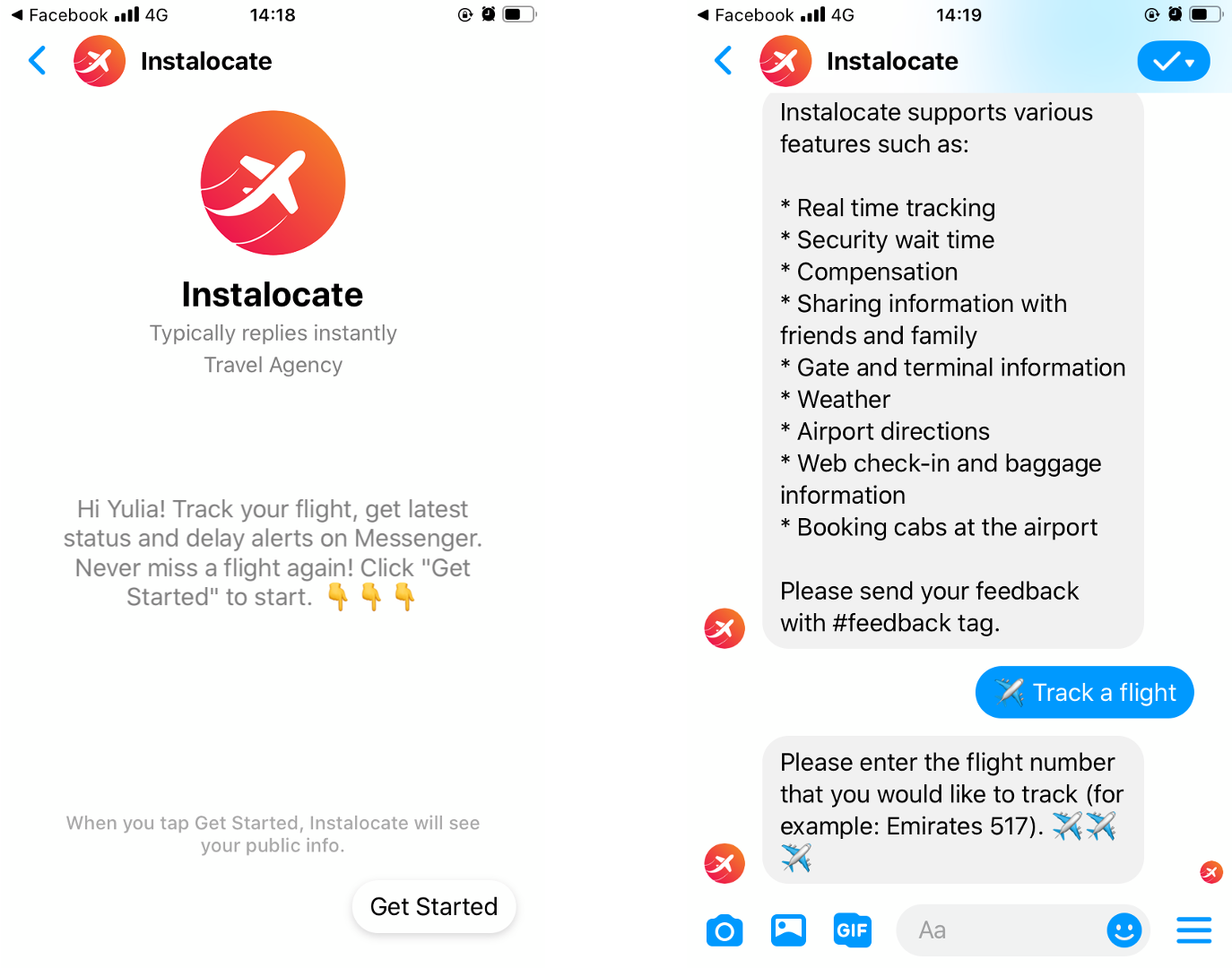
So if you are still wondering how chatbots are changing the travel industry, we’ll answer: dramatically! Now let’s look at how this translates into making money.
Travel industry chatbots help generate, nurture, and convert leads
Leisure traveling is an industry with a long purchasing cycle. People don’t go on vacation every week and every decision takes time. Customers search, read reviews, compare, and ask for advice, visiting lots of websites along the way. Chatbots can make this routine enjoyable, nurturing your leads with inspirational tips and showing them the best deals.
Skyscanner was one of the first travel brands to introduce conversational search interfaces, resulting in more than one million interactions across its chats. They see these interactions as one of the solutions for abandoned carts, which are a major problem for any travel business.
Filip Filipov,
Vice president for product management, SkyscannerWhat we’ve learned over time is if people start using a chatbot as a utility, you will still provide a lot of value and then potentially later on those people will come back and complete a transaction.
GReaTa is one of chatbots in the hotel industry that was introduced by GRT Hotels & Resorts. It talks to customers directly on the website: collects contacts and helps users book a hotel in a breeze.
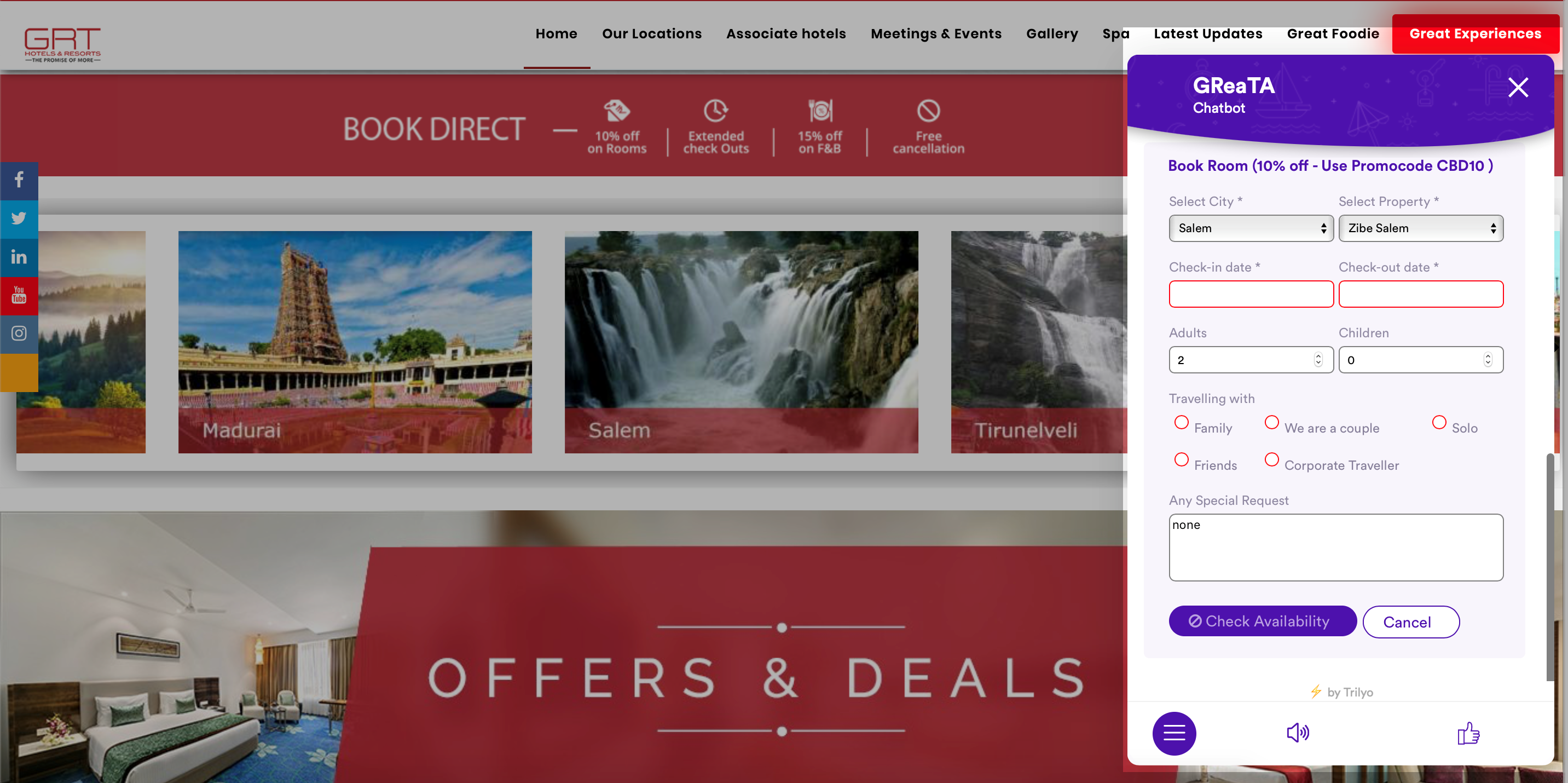
The company claims that within two-and-a-half months of its launch, GReaTa exchanged over 175,000 messages. 84% of prospects left their contact info and 40% had the intent to complete a booking.
This example shows that chatbots can become an important part of your infrastructure, replacing dull and exhausting forms. Technically, they can also integrate with your CRM and:
- provide personalized service to your regular customers;
- bring valuable insights for your prospects, if powered by AI.
All this leads to greater personalization and, consequently, higher conversion rates.
Travel industry chatbots ensure ultimate customer service
Besides bringing in customers, chatbots in the travel industry can help you continue engaging with current customers by providing timely and friendly customer service.
It goes without saying that human interaction is key, especially when there is a serious service issue. A chatbot can help your customer service agents deal with such cases, sparing them from answering basic frequently asked questions over and over.
So, don’t be afraid that chatbots will irritate your customers. According to the latest conversational marketing report by Drift, most people primarily view chatbots as a solution for getting answers.
Which of the following would you use a chatbot for?

In the worst cases, chatbots can always transfer the client to a customer service agent. The best part about chatbots is that they are available 24/7 and can answer any inquiry beyond the office hours. Just imagine how many simple queries can be filtered out!
BB or Blue Bot is KLM’s chatbot powered by AI. It helps users get assistance, check flight statuses, make bookings, and even change seats or pack their bags.
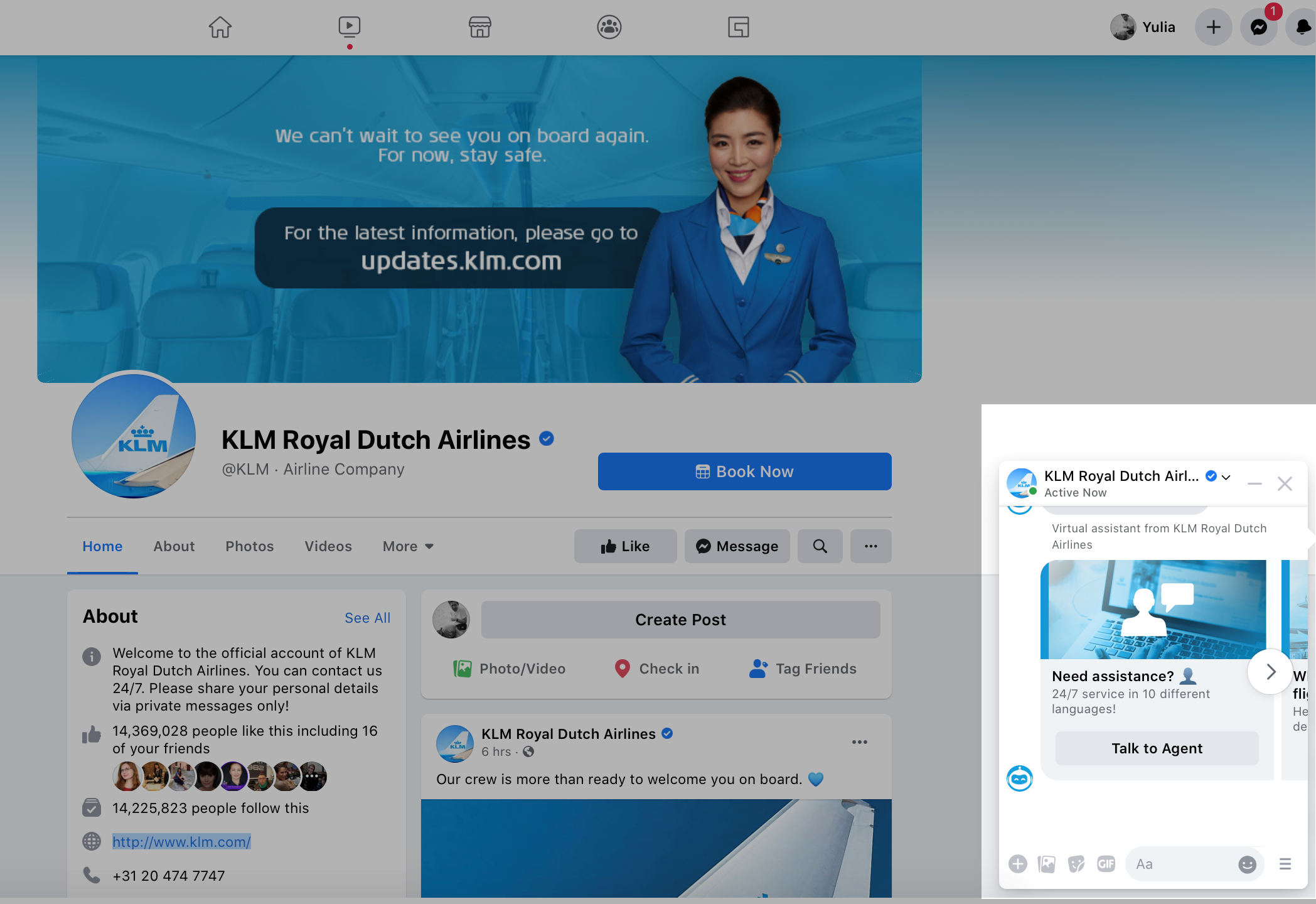
As you see, chatbots for the travel industry can be a magic wand: gaining customers and saving you time and money. Ready to try one? Grab some working scenarios with tips and examples to map out your strategy.
Scenarios, tips, and examples for building a travel chatbot
Here are some most commonly used scenarios for chatbots in the travel industry to inspire you.
Local insider: providing tips and busting myths
You can use chatbots to inform and educate your customers on a variety of subjects:
- destination overviews and the best tours for a specific season;
- places of interest, city and hotel highlights;
- tips on how to get ready for a specific trip;
- available activities, from outside yoga to laser tag;
- best deals and price alerts.
Getting back to the COVID outbreak, a chatbot can provide information on when a country of destination opens and what kind of restrictions exist for tourists. There is a lot of misleading information and myths around the situation, so this can be a helping hand.
There is already a variety of such chatbots the hospitality industry can offer. For instance, the Telegram bot, @hotelhuntbot, will watch the prices for a hotel you would like to stay at and send alerts if they change. The only thing you have to do is send a link to the hotel’s page on Booking.com.
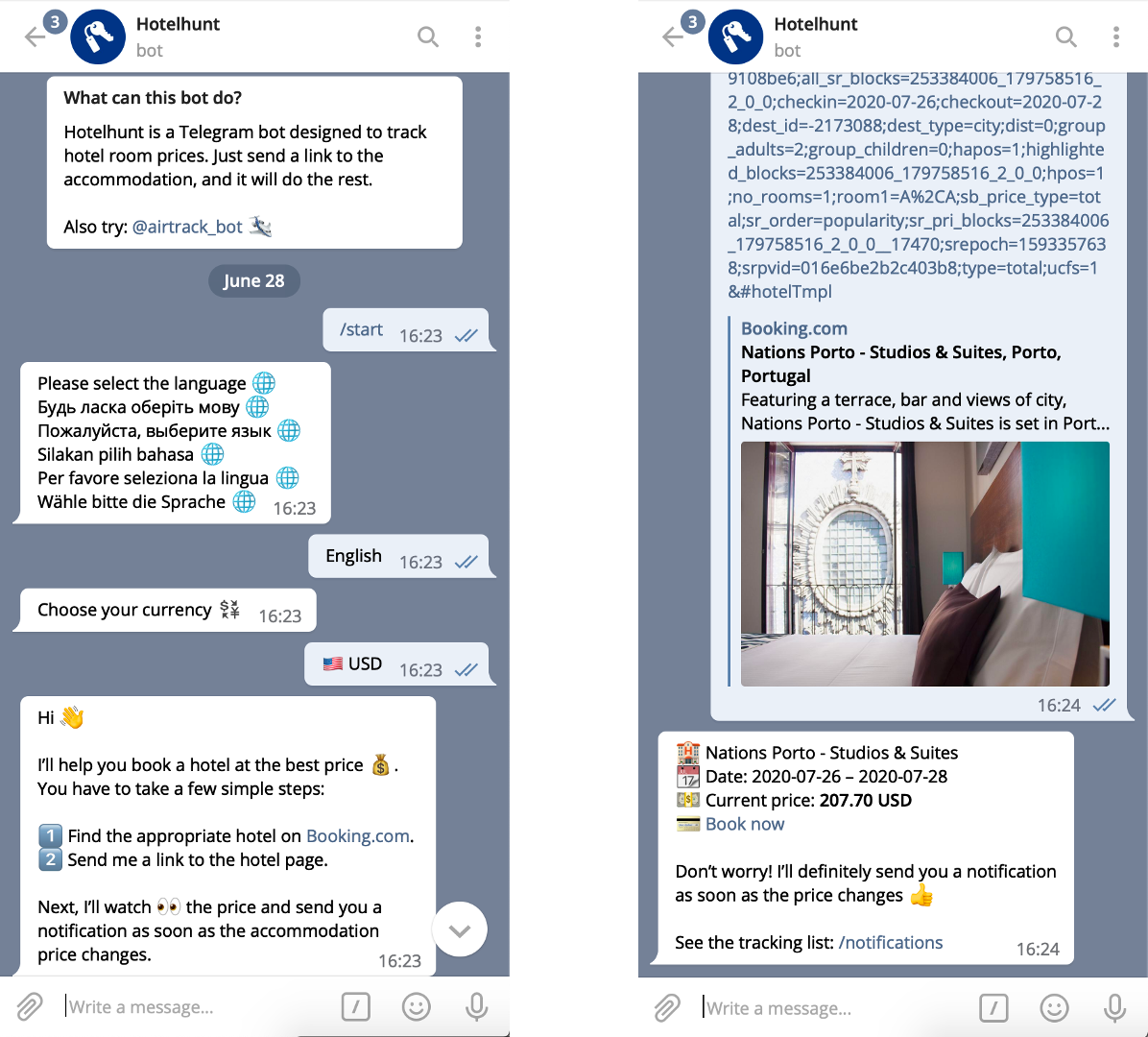
Needless to say that this type of chatbot can help you nurture and convert leads better. A bot like this can also contribute to customer loyalty. By providing travelers with valuable information, you show that you care about their experience, not the money.
Tip: To give a perfect tip, program your chatbot to ask questions first. This way, you’ll get a better chance to hit the nail on the head and offer a really valuable piece of advice.
Flight and hotel booking assistant
These chatbots can facilitate a simple user experience, helping them to make a booking without filling out forms or browsing through aggregators that are usually overloaded with ads and banners. Apart from making reservations, travelers can change or cancel them.
Most international airlines, hotels, and car rental companies have already adopted chatbots on their websites and Facebook pages to offer their clients another convenient way to interact.
There are also some independent apps that claim to bring the best prices using price predictions. For instance, Waylo claims to eliminate hotel price fluctuations and offers exclusive discounts on predicted surplus hotel rooms. Their chatbot can book hotels at the best prices and also help with travel ideas.
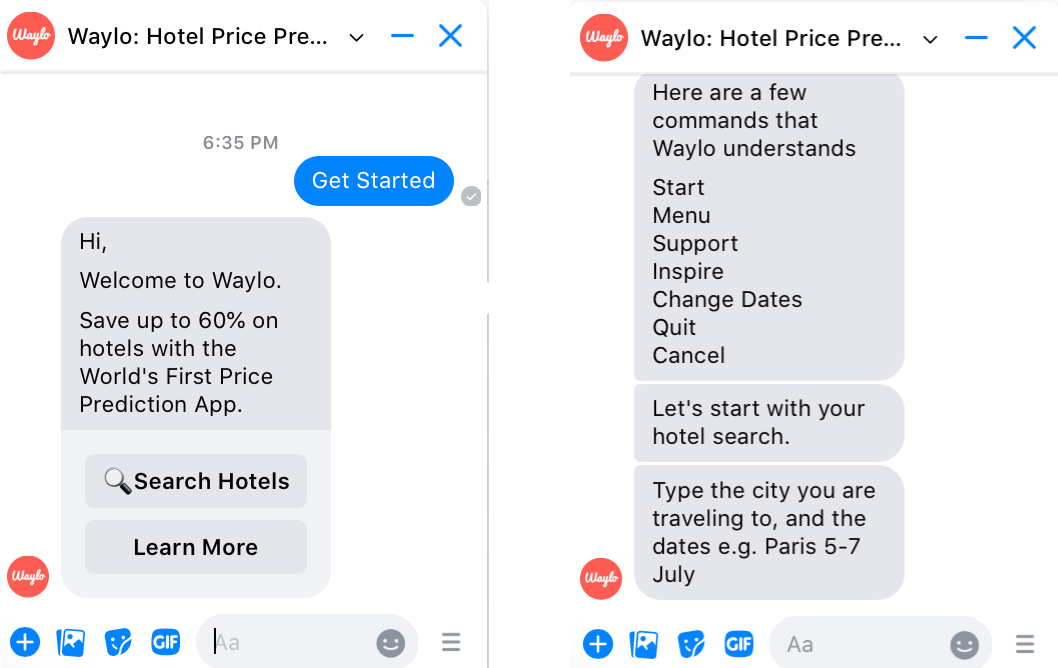
Tip: Integrate a payment gateway, so that your prospect can pay right away, without moving to any other website. Facebook Messenger and Telegram allow payment systems as of 2016.
24/7 customer service agent
Answering simple questions is the number one task a chatbot can spare you from.
Here are some other things travel industry chatbots can do in terms of customer service:
- manage bookings;
- restore passwords;
- resend confirmations;
- collect feedback and ask for guest reviews;
- guide users through the cancelation and compensation process.
A very important thing to remember: always leave an opportunity to contact a customer service agent. In the example below, Air New Zealand is very genuine and suggests human help “if his microchips malfunction.”
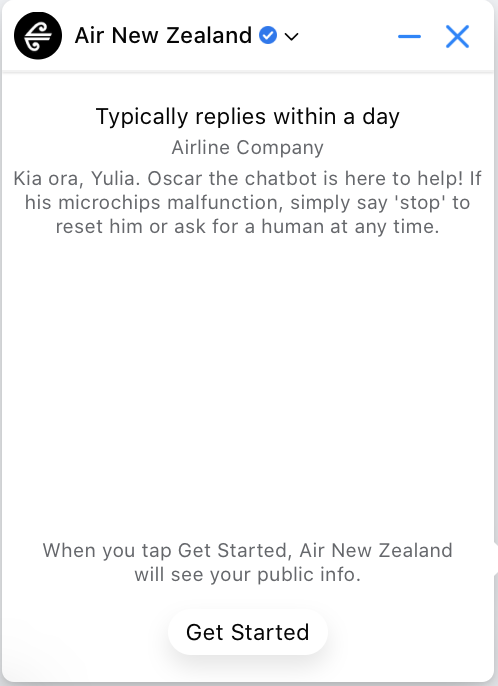
Tip: Give your chatbot a personality, give it a name, and set a tone of voice. Stay relevant to your brand and the audience segment you are targeting. For instance, if you own a five-star boutique hotel, it could be an online concierge giving sophisticated advice and suggesting attractions based on the guest’s interests.
How to get users for your travel chatbot
You’re probably wondering how to get people to use your travel chatbot, and the good news is that it is pretty easy to do. There are at least three ways to pick the one that matches your audience profile.
Make use of direct response marketing
To get current customers to use your chatbot, you can use direct response marketing techniques: email marketing, SMS and push messages, printed flyers, and outdoor ads with QR codes and short links, or even direct mail.
Email marketing campaigns are a good option, as here you can explain all the perks and provide a direct link.
Tip: Before you create an email campaign to promote your travel chatbot, think of how it will be built into your overall email marketing strategy. For instance, in case you are thinking about a customer service chatbot, you can add the link to all the triggered email flows, suggesting your chatbot as one more means of getting in touch.
With SendPulse, you can craft both triggered emails and promotional campaigns without coding. Just play with our intuitive drag and drop email builder and ready-to-use templates. There are also personalization and segmentation options to make your emails as relevant as possible.
If you have an offline travel agency, another way to attract users is to print postcards with QR codes and hand them out. Your customers can scan the link to get special offers and member discounts.
Unlock the power of Facebook
If you want a larger potential audience to interact with your chatbot, you can:
- invite people who have interacted with your page or group;
- use paid ads with go-to Messenger calls to action.
In the first case, these can be users that left you a comment or liked your page. In your welcome message, you can introduce yourself and ask users to subscribe to the bot to get the best ideas, discounts, or travel tips. These messages can be manual or automated — The Facebook API is quite flexible and allows you to create flows, triggered by a specific word or reaction.
Collect subscribers on your website
With SendPulse, you can add a signup widget to your website and help your audiences join the bot in two clicks. The best part of it is that they can start communicating with your chatbot right on the website, without being redirected to messengers. The widget can be easily customized to your needs and designs.
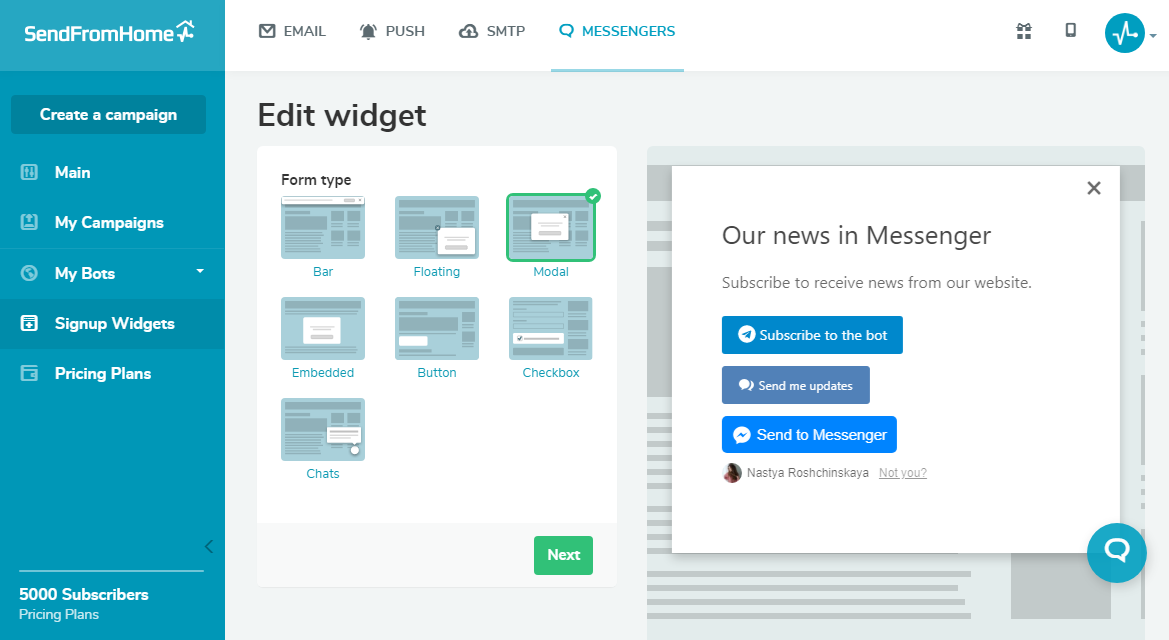
Building travel industry chatbots with SendPulse
With SendPulse, you can create chatbots for Telegram and Facebook messengers in a blink of an eye. The process is intuitive due to a drag-and-drop flow builder.
Let’s imagine you have a local tour agency arranging tours to the USA and UK. You want to keep your customers informed about the COVID situation in these countries and keep them inspired about the journey. This is how a simple chatbot flow for Telegram might look.
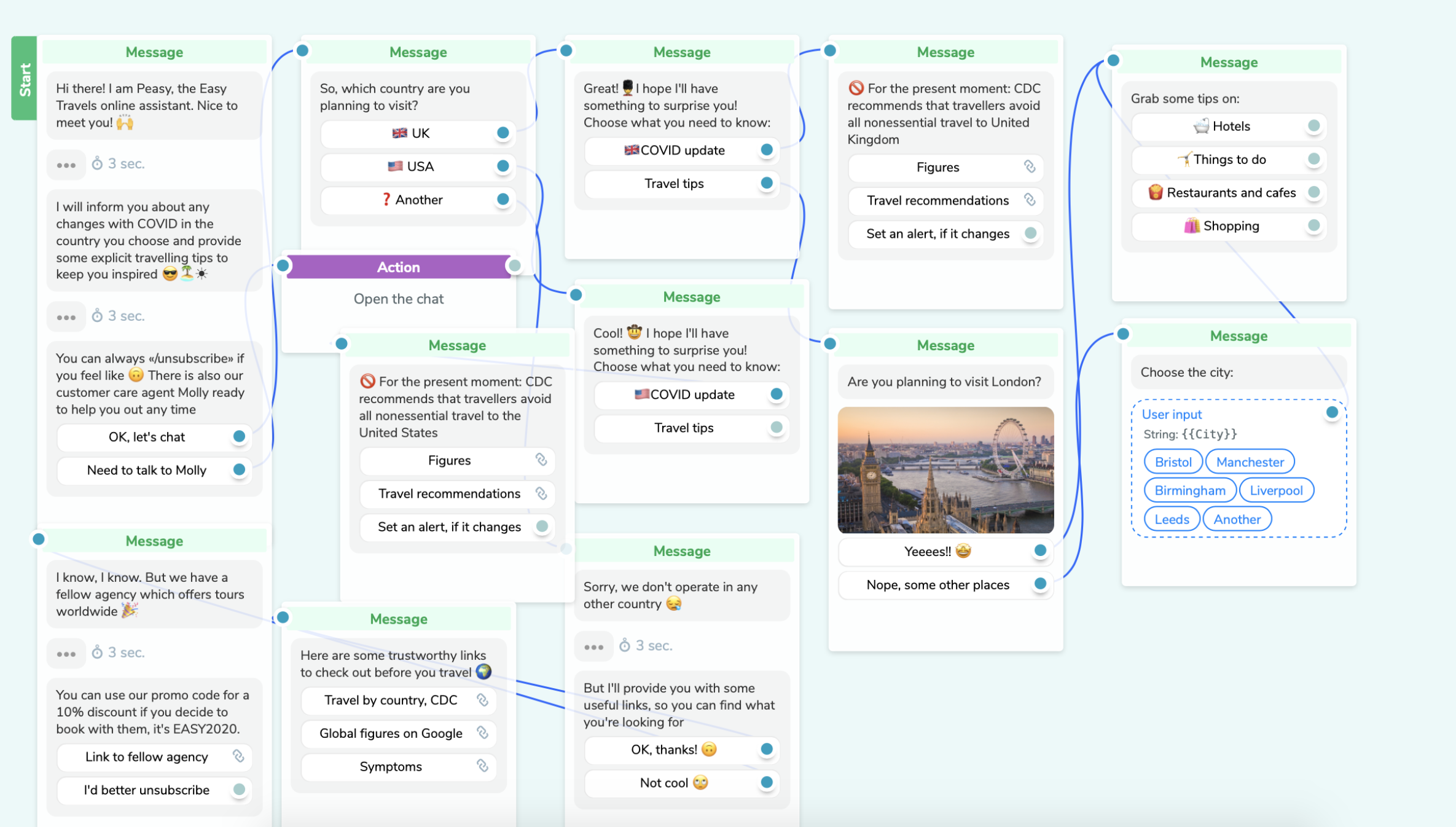
It all starts with a welcome flow. Here you should describe the perks of subscribing to your chatbot and let your customer know how to unsubscribe if needed. You can also add a talk to a human option right away.
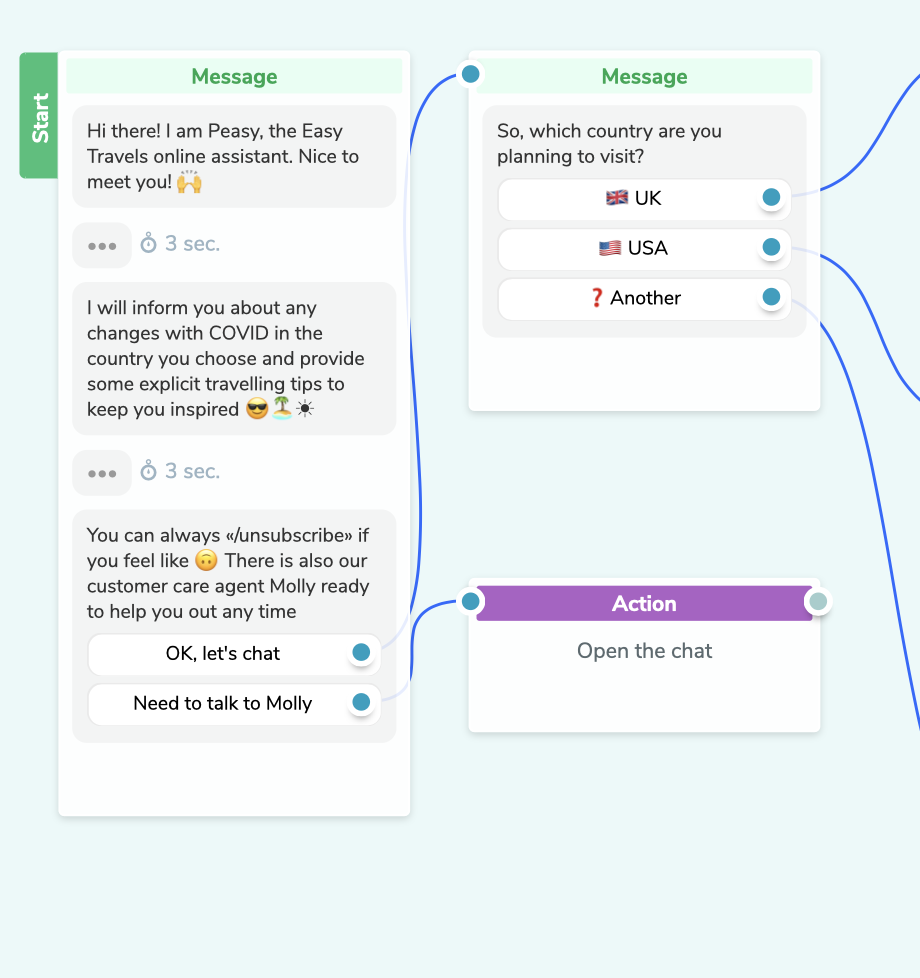
Then your flows can be split into several new ones depending on the choice of a country. Whichever option is chosen, you can provide the visitor with all the information, adding:
- links;
- images;
- promo codes;
- actions like unsubscribe.
In our example, if users choose a country, they can get either a COVID update or travel recommendations or tips for visiting London or other cities. You can further develop the recommendations and even offer to send alerts.
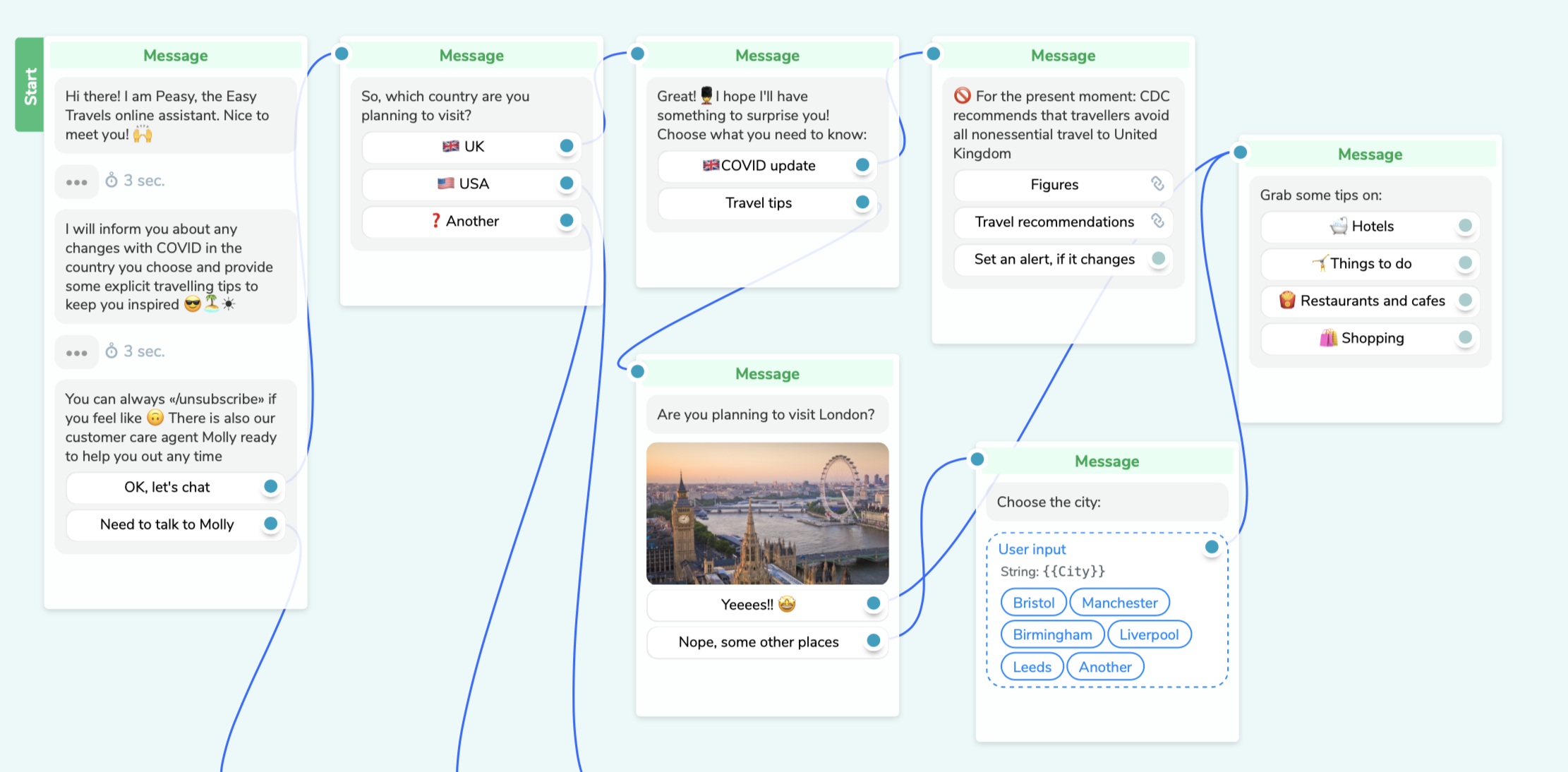
Users navigate through the flow by hitting the buttons or choosing from quick replies. You can also add fields to collect emails or phone numbers.
Tip: You’d better plan the logic of the chatbot and collect all the content before you go to the builder. This way, the task will take you the minimum amount of time and be really enjoyable to use.
To finish up
Travel industry chatbots are a top-ranking technology that can help travel professionals in many ways. Due to the fact that travelers use mobile phones and messaging more than ever, chatbots can create unique and wholesome experiences, caring about the user from the beginning to the end.
- Use chatbots to engage with your current customers and generate, nurture, and convert leads.
- Make use of three main scenarios or jobs a chatbot can spare you from: a local insider, a booking assistant, and a customer care assistant.
- Collect subscribers for your chatbot, using direct response marketing techniques and subscription widgets on your website.
Sign up with SendPulse to easily craft travel chatbots for Telegram and Facebook!






